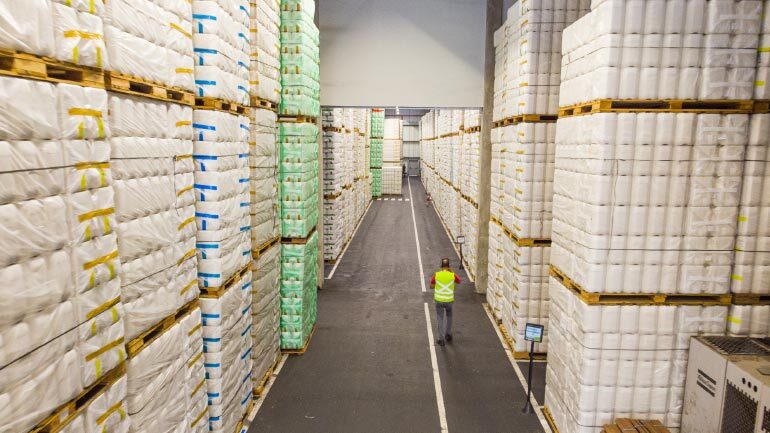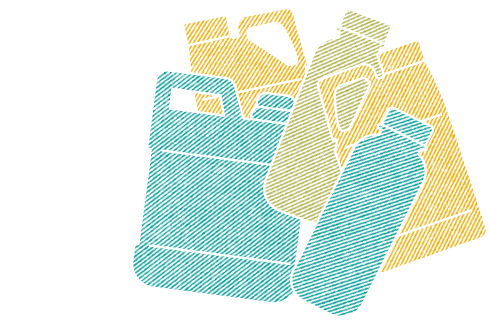The Campo Limpo System is the Brazilian reverse logistics program for empty crop protection packaging or that containing post-consumption leftovers and assembles the manufacturing industry, the distribution channel, farmers and government. Each one of these links has its own role and responsibilities defined by legislation to promote the reverse logistics and provide adequate eco-friendly disposal to these packages.
inpEV (National Institute for Processing Empty Packages) is the entity that manages the System, and the entire process is regulated by Law 9.074/00 and its regulatory decree 4.074/02.
The Campo Limpo System is responsible for correctly disposing of 94% of all primary plastic1 crop protection packages placed in the market. Besides this, of every 100 containers, 93 return to the productive process in the form of new safe and certified agri-chemical packaging, or artifacts employed in civil construction and in the automotive, energy and other industries. The remaining 7% that cannot be reinserted in the productive process are incinerated in an adequate eco-friendly disposal process. GRI 301-3
These numbers place the System as a global reference in reverse logistics and an example of circular economy (read more on Human development). In order to maintain this track record, the System is present in all Brazilian states and in the Federal District, having 410 fixed units (outposts and central stations), besides itinerant collection stations in order to be close to rural producers. GRI 102-6
1 Primary packages are those that are in contact with the product.

A reference in the circular process GRI 103-2, 103-3 & 306-2
The receipt of empty crop protection packaging and its transformation into a new, safe and efficient container reinserted into the market is a virtuous cycle promoted by the Campo Limpo System that sets it as a reference in circularity.
Besides material reinsertion, mainly plastic, in the industry, this cycle prevents these components from inadequately remaining in nature and thus contaminating the soil and water, besides reducing the demand to extract fresh materials for production purposes.
Ecoplástica®, an international reference regarding performance and safety for the agro-chemical segment, is made by Campo Limpo Plastic Transformation and Recycling S.A. Its high performance sealing system, Ecocap®, is manufactured by Campo Limpo Tampas e Resinas Plásticas Ltda. Both companies were conceived by inpEV and their profit is reinvested to cover the System's costs.
Product development was a milestone in the System's history and, besides closing the productive cycle, is a market innovation that demonstrates the feasibility of producing crop protection packaging using recycled resins with high performance, safety and certification for ground and maritime transportation.
Circular economy
A new way of designing, producing and consuming that respects the limits of our planet. Its residue becomes raw material once again for the same production (closed cycle) or its components are sent to other industry segments (second life).
Receiving network
The receiving structure for empty packaging or that containing post-consumption leftovers is capillary, present throughout the national territory, and planned to be near farmers. It is operated based on robust planning that ensures maximum efficiency of the process and stays in pace with the dynamics of the Brazilian agribusiness.
The post-consumption packaging receiving stations are divided into outposts and central stations, classified according to material volume and processing needs (done only at central stations).
In 2020, the System had 99 central stations and 312 outposts. As part of a continuous efficiency development process and resulting from a negotiated process, since 2019 the central stations are transferring their administration to inpEV - until then, most central stations and outposts were managed by the distribution channel. Until now, 45 have already been incorporated under the Institute's management, 17 in 2020 alone. GRI 102-10
The direct central station management process was recommended, after thorough analyses, by the inpEV Board of Directors, the body formed by representatives of all links of the Campo Limpo System. The purpose is to advance under an integrated management of these units, which may result in benefits to the System, including cost reductions for all links of the chain. As the managing entity, inpEV has knowledge of the entire packaging disposal process and disseminates good practices on topics such as environmental management, promotion of a safe and efficient working environment.
Even with the new coronavirus pandemic and the mobilization to ensure worker safety, the plan to change the central stations continued on schedule until the end of the year. Team integration processes, trainings and operator hiring, whenever necessary, were done in a virtual fashion in order to guarantee the health of those involved (read more on Human development). Another concern of the process is to maintain proximity among the central station, the distribution channel and the farmers in each region, thus ensuring a good relationship and communication between these strategic links of the System.
Another benefit of the integrated management was to expedite and make decision-making more efficient along the year, mainly with regard to the strong demand for receiving packaging without any bottlenecks in the System.
Forms of disposal GRI 306-2
All types of regularly commercialized crop protection packaging are disposed of by the Campo Limpo System, including the plastic and metal packaging, lids and cardboard boxes used during transportation.
Packaging that has not been submitted to a triple wash in the field, under the responsibility of farmers, or containing crop protection post-consumption leftovers - around 7% of the total disposed volume - is incinerated by specialized companies. This includes products that farmers did not use until the end, overdue or presenting damaged packaging the prevents its commercialization. Discontinued products that had their registry canceled, but are not prohibited, are also incinerated.
Co-processing brings forth an environmentally more interesting alternative than incineration. inpEV conducted studies on this procedure between 2014 and 2016, including tests in partnership with Cetesb (Environmental Agency of the State of São Paulo), which demonstrated efficiency and safety. This procedure, which only includes empty packaging, is more efficient than traditional incineration and can become a substitute for fossil fuels in these furnaces. This is also in agreement with international regulations such as the Stockholm Convention. inpEV is still assessing the impacts of this option and continues to recycle and incinerate as a means of final packaging disposal.
RESIDUE MANAGEMENT1 (t) | ||||||
TOTAL GENERATED | RECYCLED | INCINERATED4 | ||||
| 2019 | 2020 | 2019 | 2020 | 2019 | 2020 |
Non hazardous2 | 42,528.2 | 45,676.2 | 42,528.2 | 45,676.2 | 0.0 | 0.0 |
Hazardous3 | 3,165.7 | 4,303.5 | 362.7 | 850.6 | 2,803.0 | 3,453.0 |
Total | 45,693.9 | 49,979.8 | 42,890.9 | 46,526.8 | 2,803.0 | 3,453.0 |
1 All residue processing is done externally, by partnering recyclers and incinerators.
2 Steel, aluminum (IBC container cage and packaging), washed plastic packaging of co-extruded polyethylene (COEX) and high density polyethylene (HDPE), cardboard and lids.
3 Rigid unwashed packaging, flexible unwashed plastic packaging, IBC container bag, aluminum hydroxide, glass packaging and packaging containing liquid and solid post-consumption leftovers.
4 Includes the packaging received with post-consumption leftovers (131 tons in 2019 and 99 tons in 2020).
DISPOSED PACKAGING (t) PER STATE – 2020 | ||
|---|---|---|
Mato Grosso | 12,872.5 | 26% |
Paraná | 6,507.9 | 13% |
São Paulo | 5,434.4 | 11% |
Rio Grande do Sul | 5,296.3 | 11% |
Goiás | 4,709.6 | 9% |
Mato Grosso do Sul | 3,674.9 | 7% |
Bahia | 3,669.1 | 7% |
Minas Gerais | 3,222.5 | 6% |
Maranhão | 925.0 | 2% |
Tocantins | 751.6 | 2% |
Outros | 2,817.4 | 6% |
Total1 | 49,881.1 | 100% |
1 Does not include received post-consumption leftovers.


